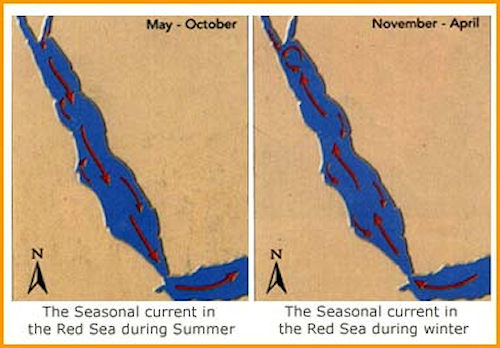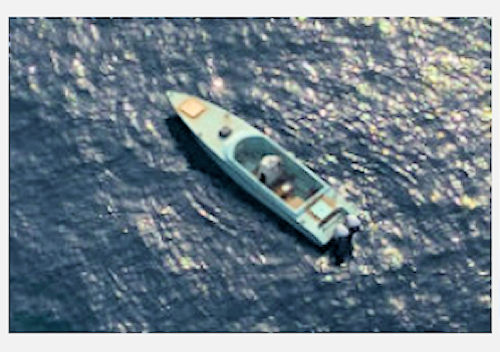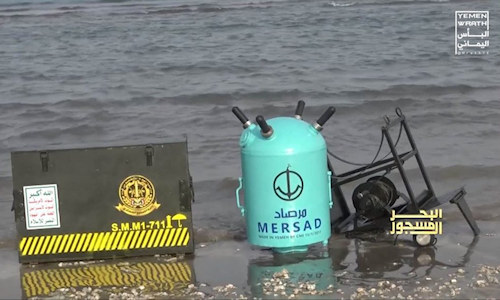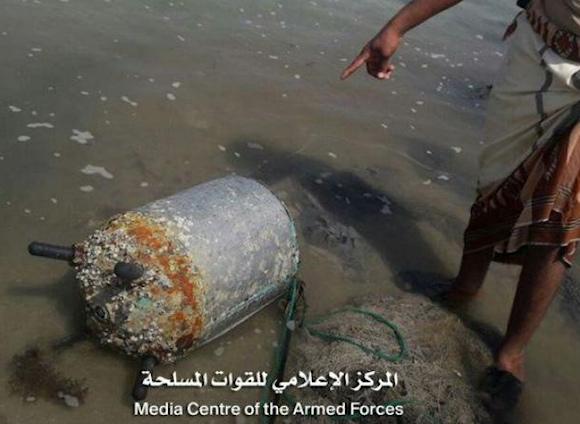If it is true that tactics are used to win battles and strategy to win wars, the most strategic naval weapon always appears to be the old but still cost-effective mine.
You will remember the discovery of naval mines laid by the Houthis defined on 30 May 2022 by Al Ain News as the "floating death“. It was a primitive device that had "detached" from its mooring cable and had been transported by wind and sea to a beach in the province of Al-Hodeidah, still under the control of the legitimate Yemeni government.
At the time it was estimated that hundreds of mines were, more or less randomly, drifting in the southern waters of the Red Sea, carried by the currents towards the Gulf of Aden. In fact, the news immediately caused a sensation and the Yemeni coast guard requested the intervention of the sappers of the United Arab Emirates (UAE), belonging to the Saudi project for mine clearance in Yemen (MASAM), who safely detonated the bomb.
This was immediately followed by a request to the United Nations to pressure the Houthi militias, supported by the Iranian government, to stop laying mines and support mine clearance efforts in those waters.
Since July 2018, the MASAM, sponsored by King Salman humanitarian aid and relief center (KSrelief), has removed 10% of the land mines laid by the Houthis in Yemen which, at the end of January 2019, was over 127.400 mines. The discovery of ordnance at sea quickly turned into a “clear and present danger” which could have widened the danger zone to include international traffic. The spokesperson of the Arab coalition Turki al-Maliki announced, on February 7, that three Egyptian fishermen had been killed and three others injured when their boat hit a bomb in international waters in the Red Sea, underlining that "The continuous deployment and placing of naval mines by the Houthis represents a real threat to the flow of maritime shipping and international trade in the Bab al-Mandeb Strait and the southern Red Sea."
 Unfortunately, despite the efforts of the Coast Guard, the known victims among local fishermen have risen to over 100. The danger of these weapons lies in the fact that the possible targets are not definable and anyone can run into a drifting mine; the increase in the aggressiveness of the Houthis with attacks on ships in transit and boarding of merchant vessels considered to be the property or interest of Israel, means that this threat could be intensified with new poses, extending on the routes affected by international maritime traffic that crosses the strait to and from from Suez.
Unfortunately, despite the efforts of the Coast Guard, the known victims among local fishermen have risen to over 100. The danger of these weapons lies in the fact that the possible targets are not definable and anyone can run into a drifting mine; the increase in the aggressiveness of the Houthis with attacks on ships in transit and boarding of merchant vessels considered to be the property or interest of Israel, means that this threat could be intensified with new poses, extending on the routes affected by international maritime traffic that crosses the strait to and from from Suez.
Although the Arab coalition's means of intervention have reduced the maritime threat with the identification and destruction of 137 of the mines laid by the Houthis in Bab al-Mandeb and in the southern Red Sea, in particular off the islands north of the three ports of al -Hodeidah, Saleef and Ras Issa, analysts believe that the underwater weapons in the possession of the rebels are still many and diverse, representing an insidious danger. This aggravates the danger for maritime commercial traffic subject to attacks with different types of drones and missiles.
What is the threat?
Going back in time, the attack on the Saudi frigate at Madinah in the southern Red Sea on 29 January 2017 was carried out by a remote-controlled explosive vessel (following image) which hit the stern of the frigate, killing two sailors and wounding three. These ships are defined by some sources as “water-based improvised explosive devices” (WBIED).
Some specimens were captured which turned out to be surface drones of about 10 meters in length made by Al Fattan Ship Industry in the United Arab Emirates which had been donated to Yemen before the outbreak of the war and then modified for an offensive role. Although the report of Al Ain News mentions that during mine removal operations three different types of underwater devices were identified in the Red Sea, it is not excluded that new weapons may be used, purchased on the black market or developed on the basis of existing ones of Iranian or Russian origin.
 Among the information available online, some improvised devices discovered in Al Mukalla, Yemen, planted by Al-Qaeda forces before their withdrawal should be mentioned. Apparently primitive remote-activated devices were discovered by local divers who immediately alerted the coast guard. Of greater concern, however, is the discovery of several devices discovered near the coast. At the moment it would appear that the Houthis have used two types of Iranian-built naval mines, Sadaf and Qaa, and some (home-built) of varying sizes very similar to domestic gas cylinders equipped with four explosive shocks; ironically, these have proven to be the most treacherous for fishermen.
Among the information available online, some improvised devices discovered in Al Mukalla, Yemen, planted by Al-Qaeda forces before their withdrawal should be mentioned. Apparently primitive remote-activated devices were discovered by local divers who immediately alerted the coast guard. Of greater concern, however, is the discovery of several devices discovered near the coast. At the moment it would appear that the Houthis have used two types of Iranian-built naval mines, Sadaf and Qaa, and some (home-built) of varying sizes very similar to domestic gas cylinders equipped with four explosive shocks; ironically, these have proven to be the most treacherous for fishermen.
These would be mines anchored with a cable to a metal base located on the bottom, positioned about two meters from the surface. Being below the surface of the water their discovery is not always easy. Furthermore, the mooring device appears to be rather fragile and breaks easily... which suggests that all moored devices are generally equipped with "discharge vaults" on their lower side which prevent the cable from coming under tension during the rotation of the mine caused by currents or the motion of the sea. One could therefore ask whether the breakage is linked to a construction defect or an intentional fact.
The removal and destruction of these mines is not technically complex but their greatest insidiousness derives from the difficulty of identifying them. Furthermore, passive mine countermeasures systems supplied to naval ships are effective against magnetic-acoustic triggering devices but have no effect on colliding mines; although sonar systems exist mine avoidance (suitable for discovering and avoiding mines on the surface or in the first meters of water) the probability of discovery is not high and they must be discovered optically (by anti-mine lookouts or by helicopters in advanced patrol) or with active sonar systems such as those supplied to the minehunter unit.
 These specialist units are supplied to Western navies but require secure logistical bases near the areas of operation and support from larger units to protect them from attack by surface combatant units, air units and drones. Furthermore, once safe transit channels are opened, it is still necessary to guide maritime traffic to and from safe, mine-free areas.
These specialist units are supplied to Western navies but require secure logistical bases near the areas of operation and support from larger units to protect them from attack by surface combatant units, air units and drones. Furthermore, once safe transit channels are opened, it is still necessary to guide maritime traffic to and from safe, mine-free areas.
The international task force that is being formed in the Red Sea will certainly be able to counter any drone attacks by the Houthis but it could find itself in a complex situation if the threat were to transform from two-dimensional (air-surface) to three-dimensional, therefore including the underwater domain . It would therefore be appropriate to have a plan in place in time task group of mine countermeasures units supported by a command unit of an adequate level both from a logistical and communication point of view and a forward logistics site located in an area close to the areas of operation, with adequate maintenance and logistics capabilities for long-term support. It should be well understood that transfer times are a sensitive factor in order to optimize both interventions at sea and maintenance and supplies of food and ammunition.
The use by the Houthis of Iranian-built underwater weapons raises the possibility that the mines could be laid in a more "intelligent" way as they are also equipped with acoustic and magnetic sensors (such as the AMD 1-500, a type of mine developed by Russia in 1942 and still present on the arms market). In this case, as there is a shortage of minesweepers in Western arsenals, the most adequate means of contrast would remain the minehunters that have proven their greater effectiveness during past operations in the Persian Gulf and the Adriatic.
It should be underlined that this threat therefore has a direct impact on international merchant traffic and the local fishing sector: in fact around half a million fishermen work in the waters off the western coast of Yemen, supporting around 1,7 million people with their caught. So far the presence of naval mines has caused the death of around a hundred of them and is putting their only source of income at risk, which is worsening the terrible and often forgotten humanitarian crisis in Yemen, highlighted by the United Nations Secretary General António Guterres as the “worst in the world”.
Due to its important implications on maritime safety we will continue to follow the situation of Bab el Mandab, the name in Arabic which stands for "door of tears" (or of the funeral lament), an unfortunately appropriate name that fishermen (or rather their wives) attribute to that perilous sea route.
Photo: web / HI Sutton
(article originally published on https://www.ocean4future.org)












